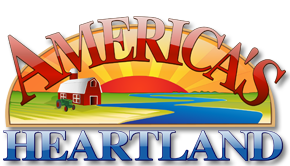Never in the history of television has there been a show with the scope and unique purpose like America’s Heartland. This weekly series about the people, places and processes of American agriculture started as most good things do, with a simple idea hitched to a vibrant vision.
The show originally started as California Heartland and was a hit in the Golden State, even the San Francisco market. Some visionary folks at the Farm Bureau in that state got behind this magazine formatted show and it grew in depth and dimension until it became obvious to those involved that Heartland could succeed on a national platform.
A key player in this big idea is former California Farm Bureau President Bob Vice who says farmers and ranchers are serious about having to continually educate a population mostly removed from their agrarian roots. It was obvious to him that public television was an excellent medium to tell the stories of the families who grow our food, fiber and fuel.
It took a couple of years to secure the proper funding for such a huge endeavor and to shoot enough shows for the first season. The plan was to offer the show to PBS stations nationwide and to provide financial backing from a number of sources to cover production and other costs.
Heartland debuted on the national airwaves in 2005 and has been gaining audience and supporters ever since. The show is now completing its sixth successful season on public television stations across the land and on RFD-TV, which is billed as “Rural America’s Most Important Network.”
But the real key to the success of Heartland is its reach way beyond the rural audiences and small towns. It has managed to crossover into the major TV markets and is supported by urban residents just as strongly as folks out in the countryside. It seems the stories being told by the Heartland producers and reporters were interesting to a wide demographic swatch. An early letter writer to Heartland’s originating station, KVIE in Sacramento, Calif., said basically that she didn’t know how much she didn’t know about agriculture — until she tuned in.
Currently the program is on 230 public television stations and networks and on RFD-TV in primetime on Wednesdays and Sundays. According to series producer, Jim Finnerty, the show has excellent ratings and is on the air in 20 of the top 25 markets in the country.
As Heartland has grown and evolved over the last six years it has added even more elements to help consumers understand where their food and fiber comes from. Finnerty notes that the show’s integration into the world of social media, such as Facebook and Twitter, has “taken off like a rocket” in the past year. Heartland has a redesigned website for viewers and fans and several new features for the seventh season, including “Farm to Fork” with Dave Lieberman of the Food Network, animated nutrition features and a segment called “Ask a Farmer.”
The show and its website have also become valuable tools for educators working to bring agriculture into their classrooms and curriculum. In fact, the new web-based educational game, “My American Farm,” offered by the American Farm Bureau Foundation for Agriculture, features videos from America’s Heartland episodes. The program has a number of national sponsors, such as the American Farm Bureau, that have renewed or offered new support for the show. But there is room for more.
Noted cowboy music singer, Michael Martin Murphey, has contributed his song “Close to the Land” to Heartland as the show’s musical theme since the first season. In the inaugural year Murphey said when he would ask his audiences if they had seen the show a few hands in the crowd would go up. Today he says the hands go up like a waving wheat field.
America’s Heartland is an agricultural and broadcast success story. This surprising combination works because some farm leaders and broadcasters hitched their vision to a star that is the fantastic story of American agriculture.
Erik Ness is a new contributor to AFBF’s Focus on Agriculture commentary series. He is a media consultant and a retired staff member of the New Mexico Farm and Livestock Bureau.
Related Articles:
- Move Over Farmville: Here Comes My American Farm
- America’s Heartland: Still Breaking Ground



